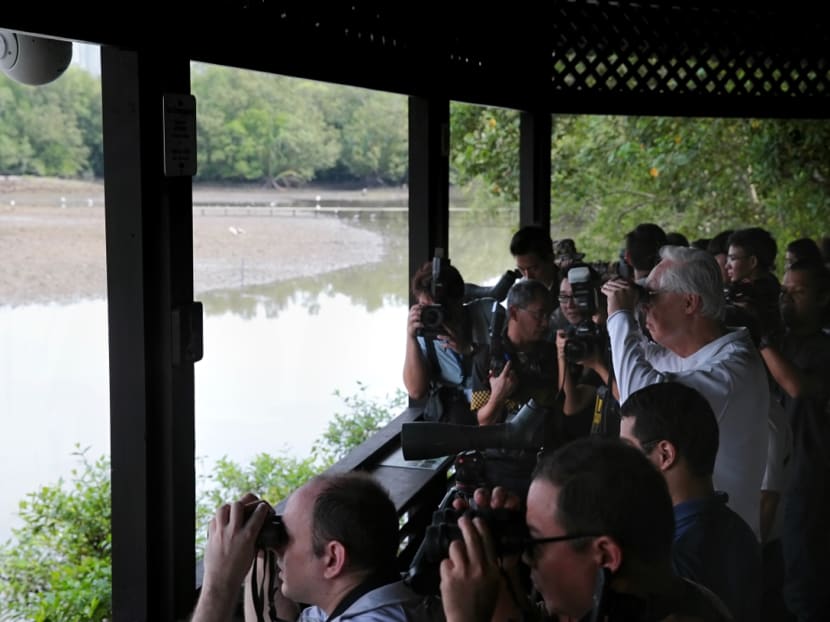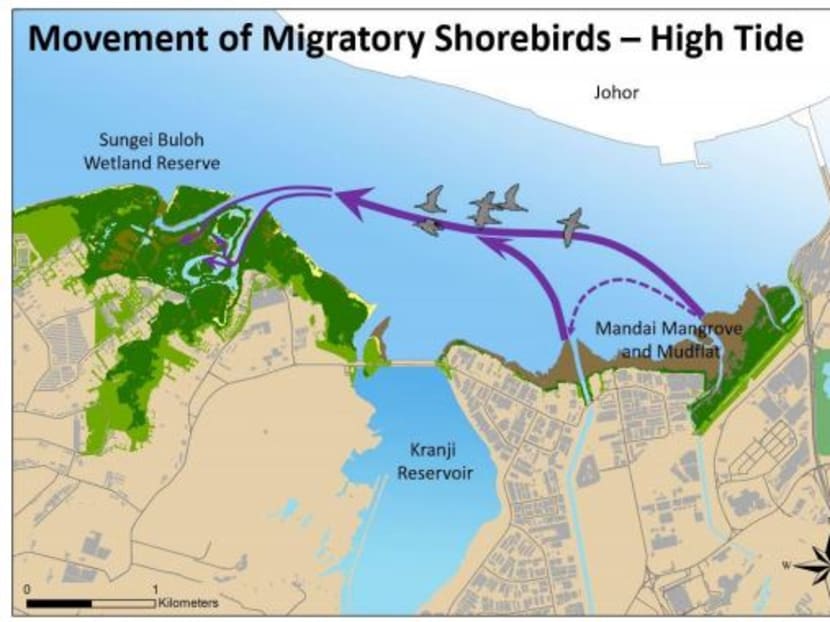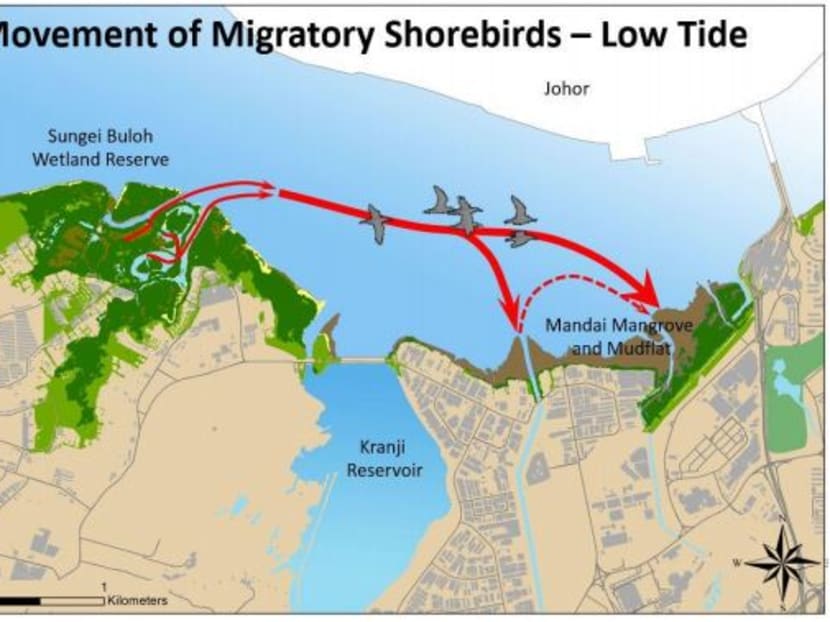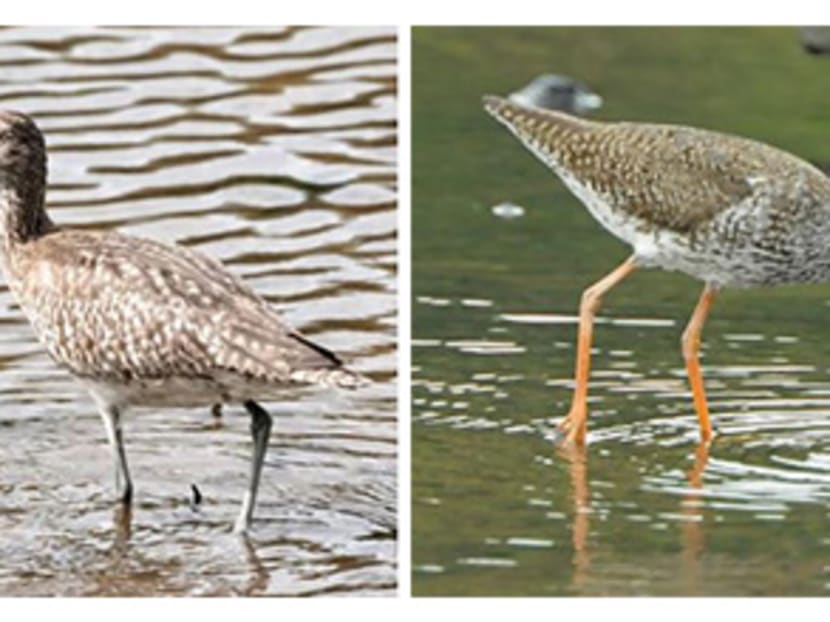Mandai mangrove and mudflats to be Singapore’s newest nature park
SINGAPORE — The Mandai mangrove and mudflats, a rich feeding ground for migratory birds and home to the vulnerable Mangrove Horseshoe Crab, will become Singapore's newest nature park in mid-2022.

ESM Goh Chok Tong (centre, in white) uses a binoculars to observe wildlife at Sungei Buloh. He was the Guest-of-Honour at the 25th anniversary celebration of Sungei Buloh Wetland Reserve, where it was announced that the Mandai mangrove and mudflats would be Singapore’s newest nature park, October 7, 2018.
SINGAPORE — The Mandai mangrove and mudflats, a rich feeding ground for migratory birds and home to the vulnerable Mangrove Horseshoe Crab, will become Singapore's newest nature park in mid-2022.
The announcement on Sunday (Oct 7) by Second Minister for National Development Desmond Lee was widely welcomed by members of the nature community.
The new status will allow the National Parks Board (NParks) to better monitor and protect threatened species of mangrove, crustaceans and migratory shorebirds, and will also give NParks teeth to enforce anti-poaching laws under the Parks and Trees Act.
"This nature park will be sensitively managed by NParks, (it) will conduct habitat enhancement measures such as coastal clean ups and mangrove replanting," said Mr Lee, whose announcement was in conjunction with World Migratory Bird Day next weekend and the 25th anniversary of Sungei Buloh Wetland Reserve.
The 73-hectare nature park, sited 3km east of the 130-hectare Sungei Buloh Wetland Reserve, is currently state land. The conserved area will comprise a 26-hectare mangrove forest, which has 16 threatened species of mangroves, and a 42-hectare mudflat.
The new nature park will complement the wetland reserve as a place for outdoor education and research, said Mr Lee, who is also Minister for Social and Family Development.
Basic amenities like bird hides, bicycle racks and a walking trail could feature at the new nature park.


From surveys and radio-tracking of shorebirds in recent years, NParks confirmed that the majority of shorebirds that roost in the wetland reserve at high tide would fly to look for food at the extensive mudflat exposed at low tide. Molluscs, crustaceans and worms are among the creatures found in abundance at the mudflat.
This means that both the mudflat and the wetland reserve are ecologically inter-dependent habitats for shorebirds.

Some 21 species of shorebirds have been recorded at the wetland reserve, with a peak count of 2,025 birds in 2012. They include the Whimbrel, Common Greenshank and Common Redshank, which are common winter visitors.
Singapore is one of 22 countries along the East Asian-Australasian Flyway, which extends from the Arctic Circle through East and South-east Asia to Australia and New Zealand. Among the world’s nine recognised flyways, it supports the greatest diversity and populations of migratory birds — over 50 million from over 250 populations — but has the highest number of threatened migratory species.
The wetland reserve is an important pitstop for migratory birds along the flyway.
Nature lovers said the move to conserve the mudflats and mangroves was a long time coming.
The ecosystem at the mudflat is “under a lot of pressure” due to pollution and an increasingly busy Johor Strait, said a “euphoric” Mr N Sivasothi, senior lecturer at the National University of Singapore's department of biological sciences.
Without management, it would be quite impossible to ensure its long-term survival, he said.
“(This will mean) either side of Kranji river is now conserved. Buloh is extremely small on its own, (so) in combination (with the mudflat), it means much better potential for a healthier mangrove ecosystem," said Mr Sivasothi.
He hopes to reduce the trash that has been collecting in “high loads” in certain areas of the mangrove. “We’ll map out the mangrove, so that we can enter (with minimal impact) and clear it out,” he said.
Mr Stephen Beng, chairman of the Nature Society (Singapore)’s marine conservation group, said the new status is “testament to the hard work (that) volunteers, researchers and managers put in over the years to establish the connectivity of Mandai mangrove and mudflats to its surroundings, like the wetland reserve”.
While a nature park “doesn’t have the same protective status as a reserve”, it signals that the area is of ecological importance, said Mr Beng.
Stakeholders should continue working together on projects such as the management of invasive mussel species, he said.
The steady growth of the non-native Charru mussels, or Mytella strigata, in recent years has led to concerns that they could out-compete native Asian green mussels and horseshoe crabs. The alien species has been sighted at places such as Sungei Buloh, Pasir Ris, Pulau Ubin and Sembawang.
The Nature Society (Singapore), NParks and the Tropical Marine Science Institute are in a partnership to deal with the invasive species, Mr Beng added.






